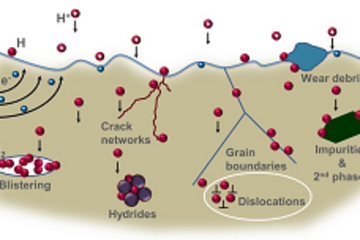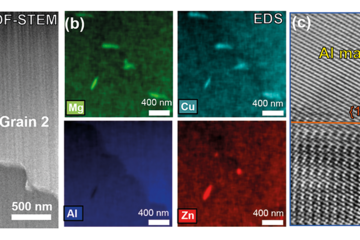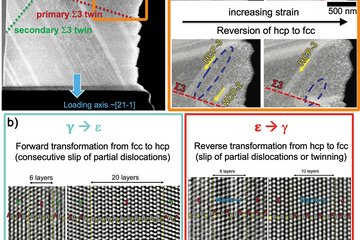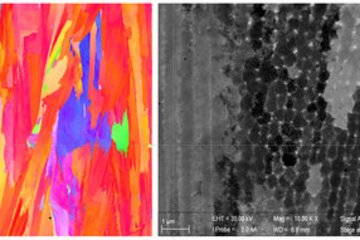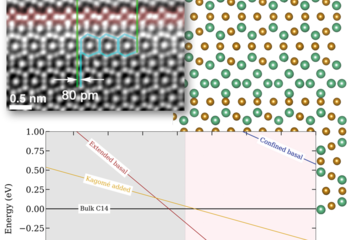All genres
501.
Talk
Atom Probe Tomography to help Understand Deformation Mechanisms in Metallic Alloys. The International Conference on Metallurgical Coatings and Thin Films 2019, San Diego, CA, USA (2019)
502.
Talk
Imaging single vacancies and atoms using joint FIM and APT experiments. Conference on Possibilities and Limitations of Quantitative Materials Modeling and Characterization, Bernkastel-Kues, Germany (2019)
503.
Talk
Chemistry and Structure of Lattice Defects. Physics Colloquium, Faculty of Physics, University Duisburg-Essen, Duisburg, Germany (2019)
504.
Talk
From Atomistic Understanding to Engineering Design of Advanced Medium and High Manganese Steels. 4th International Conference on medium and high Manganese steels, Aachen, Germany (2019)
505.
Talk
Asymmetric Line Segregation at Faceted Si Grain Boundaries. TMS 2019 Annual Meeting & Exhibition, San Antonio, TX, USA (2019)
506.
Talk
Atomic scale analysis of grain boundary deuteride growth front in Zircaloy-4. TMS 2019 Annual Meeting and Exhibition, San Antonio, TX, USA (2019)
507.
Talk
Solute segregation effect at planar defects during creep of CoNi- & Co-based superalloys. TMS 2019 Annual Meeting and Exhibition, San Antonio, TX, USA (2019)
508.
Talk
Understanding deformation mechanisms in superalloys through atomic scale microanalysis. TMS 2019 Annual Meeting & Exhibition, San Antonio, TX, USA (2019)
509.
Talk
A not-so-brief introduction to atom probe tomography: from fundamentals to atomic-scale insights into engineering materials. Seminar, Imperial College London, London, UK (2019)
510.
Talk
Local and global alloy design: metastability of single lattice defects and alloys with extreme metastability. MIT Workshop on Alloy Design, Cambridge, MA, USA (2018)
511.
Talk
Grain boundary segregation and transformation in complex alloys. MRS Fall Meeting, Boston, MA, USA (2018)
512.
Talk
Segregation and Transformation at Lattice Defects in Complex Alloys: A Microstructure Design Toolbox. MRS Fall Meeting 2018, Boston, MA, USA (2018)
513.
Talk
Segregation and Transformation at Lattice Defects as Microstructure Design Toolbox. Materials Science and Engineering Congress, Darmstadt, Germany (2018)
514.
Talk
The Role of Chromium and Cobalt Segregation at Dislocations on the γ Dissolution in Nickel Based Superalloys. 18th International Conference on the Strength of Materials (ICSMA 18), Ohio State University, Columbus, OH, USA (2018)
515.
Talk
Advancing Alloys by Segregation Engineering. 18th International Conference on the Strength of Materials (ICSMA18), Ohio State University, Columbus, OH, USA (2018)
516.
Talk
Scalable Quantifying of Evolving Descriptive Spatial Statistics in Full-Field Crystal Plasticity and Atom Probe Tomography. Institut für Metallkunde und Metallphysik, RWTH Aachen University, Aachen, Germany (2018)
517.
Talk
From Seeing Atoms Toward Understanding Atoms: Methods, Results and Challenges of Advanced Atom Probe Tomography. Hausdorff Lecture, Hausdorff Center for Mathematics, University of Bonn, Bonn, Germany (2018)
518.
Talk
Direct Observations of Atomic Hydrogen and Deuterium Interactions in Zircaloy-4. Atom Probe Tomography and Microscopy conference (APT&M) 2018, Gaithersburg, MD, USA (2018)
519.
Talk
Influence of the field evaporation conditions on compositional analysis of titanium deuteride. Atom Probe Tomography and Microscopy 2018 , Gaitherburg, MD, USA (2018)
520.
Talk
The Role of Atom Probe Tomography on the Development of the Next Generation of High Performance Materials. 4th International Congress on 3D Materials Science (3DMS 2018), Helsingᴓr (Elsinore), Denmark (2018)




